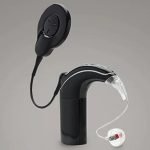Regardless of how people feel about their hearing loss, most would agree that they are lucky to be coping with hearing loss today, rather than in the past. And most would also agree that one of the big reasons for these feelings is that the technological advances of the past few years are of great benefit to hearing impaired persons. From computers to TTYs to cochlear implants to hair cell regeneration, technology to assist persons with hearing loss has exploded in recent years, and will likely continue to explode in the future.
Acoustics is the study of sound and how it behaves in an environment. A good acoustic environment is of huge importance to people with hearing loss.
Alerting devices include things like alarm clocks, smoke alarms, and doorbells. You’re probably very familiar with them. But the standard ones all rely on sound, so they provide little value to persons with hearing loss. Fortunately, modern technology has been able to provide devices that provide these functions for hard of hearing, late deafened, and oral deaf persons.
Assistive listening devices (ALDs) encompass a wide variety of devices whose purpose is to improve the audibility of sound in particular situations. Assistive listening devices are extremely beneficial to hard of hearing, late deafened, or oral deaf persons who retain some residual hearing.
The Auditory Brainstem Implant is a cousin of the Cochlear Implant that is used when the auditory nerve is not viable.
Cochlear implants are relatively recent inventions that can partially restore the ability to process sound for people with hearing loss. They seem to be especially effective for late-deafened people who have had some usable hearing in recent years. Cochlear implants are somewhat controversial within the Deaf Community, but with their growing success has come growing acceptance.
Hearing aids are one of the mainstays of personal communication for people with hearing loss. There are an incredible variety of devices available. One of the more recent advances is the digital hearing aid, which promises the ability to more closely match your hearing aid to your hearing loss.
Instant Messaging (IM) isn’t a service that is specifically intended for people with hearing loss, but it is one that is much appreciated and used by our community.
Speech recognition is a promising technology that has the capability to really open up communications to people with hearing loss. Although it is not currently commercially viable, the progress in recent years has been astounding. An accurate, usable system in the next few years in not out of the question.
The telephone is one of the basic communications tools of modern society, and the ability to use a voice telephone greatly eases the communications access problem. There are a large variety of devices that can assist people who have a hearing loss to use the telephone.
TTYs or TDDs are devices that allow persons with hearing loss to communicate without using speech over telephone lines. They looking something like a typewriter; instead of speaking, the person with hearing loss types what they want to say. instead of listening, the person with hearing loss reads what the other person has typed.
A modern telecommunications device that is taking the hearing loss world by storm is the two way pager. The hearing loss equivalent of the cell phone, these devices provide mobile communications to hard of hearing and deaf consumers.
Here’s our coverage of all kinds of captioning (TV, movies, theater, radio, etc.)
Visual Communications refers to the practice of providing visual (textual) representations of the audio information that is currently lost on people with hearing loss.




